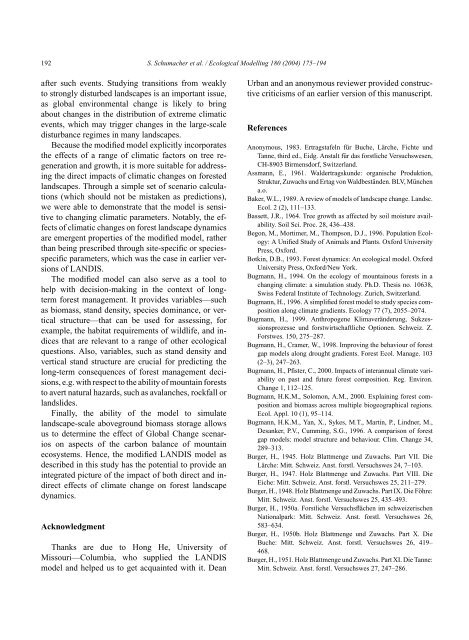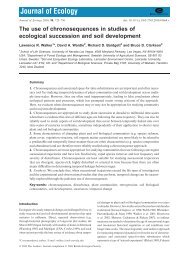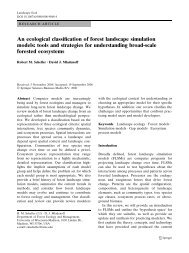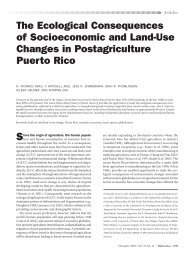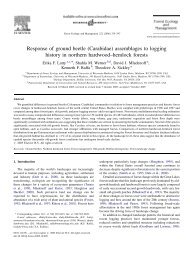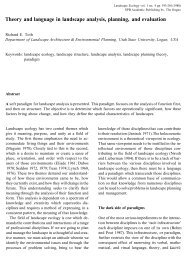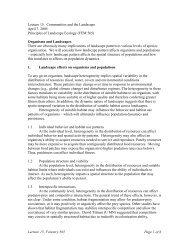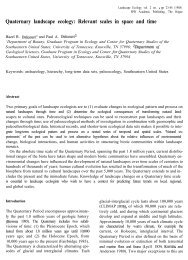Improving the formulation of tree growth and succession in a ...
Improving the formulation of tree growth and succession in a ...
Improving the formulation of tree growth and succession in a ...
Create successful ePaper yourself
Turn your PDF publications into a flip-book with our unique Google optimized e-Paper software.
192 S. Schumacher et al. / Ecological Modell<strong>in</strong>g 180 (2004) 175–194<br />
after such events. Study<strong>in</strong>g transitions from weakly<br />
to strongly disturbed l<strong>and</strong>scapes is an important issue,<br />
as global environmental change is likely to br<strong>in</strong>g<br />
about changes <strong>in</strong> <strong>the</strong> distribution <strong>of</strong> extreme climatic<br />
events, which may trigger changes <strong>in</strong> <strong>the</strong> large-scale<br />
disturbance regimes <strong>in</strong> many l<strong>and</strong>scapes.<br />
Because <strong>the</strong> modified model explicitly <strong>in</strong>corporates<br />
<strong>the</strong> effects <strong>of</strong> a range <strong>of</strong> climatic factors on <strong>tree</strong> regeneration<br />
<strong>and</strong> <strong>growth</strong>, it is more suitable for address<strong>in</strong>g<br />
<strong>the</strong> direct impacts <strong>of</strong> climatic changes on forested<br />
l<strong>and</strong>scapes. Through a simple set <strong>of</strong> scenario calculations<br />
(which should not be mistaken as predictions),<br />
we were able to demonstrate that <strong>the</strong> model is sensitive<br />
to chang<strong>in</strong>g climatic parameters. Notably, <strong>the</strong> effects<br />
<strong>of</strong> climatic changes on forest l<strong>and</strong>scape dynamics<br />
are emergent properties <strong>of</strong> <strong>the</strong> modified model, ra<strong>the</strong>r<br />
than be<strong>in</strong>g prescribed through site-specific or speciesspecific<br />
parameters, which was <strong>the</strong> case <strong>in</strong> earlier versions<br />
<strong>of</strong> LANDIS.<br />
The modified model can also serve as a tool to<br />
help with decision-mak<strong>in</strong>g <strong>in</strong> <strong>the</strong> context <strong>of</strong> longterm<br />
forest management. It provides variables—such<br />
as biomass, st<strong>and</strong> density, species dom<strong>in</strong>ance, or vertical<br />
structure—that can be used for assess<strong>in</strong>g, for<br />
example, <strong>the</strong> habitat requirements <strong>of</strong> wildlife, <strong>and</strong> <strong>in</strong>dices<br />
that are relevant to a range <strong>of</strong> o<strong>the</strong>r ecological<br />
questions. Also, variables, such as st<strong>and</strong> density <strong>and</strong><br />
vertical st<strong>and</strong> structure are crucial for predict<strong>in</strong>g <strong>the</strong><br />
long-term consequences <strong>of</strong> forest management decisions,<br />
e.g. with respect to <strong>the</strong> ability <strong>of</strong> mounta<strong>in</strong> forests<br />
to avert natural hazards, such as avalanches, rockfall or<br />
l<strong>and</strong>slides.<br />
F<strong>in</strong>ally, <strong>the</strong> ability <strong>of</strong> <strong>the</strong> model to simulate<br />
l<strong>and</strong>scape-scale aboveground biomass storage allows<br />
us to determ<strong>in</strong>e <strong>the</strong> effect <strong>of</strong> Global Change scenarios<br />
on aspects <strong>of</strong> <strong>the</strong> carbon balance <strong>of</strong> mounta<strong>in</strong><br />
ecosystems. Hence, <strong>the</strong> modified LANDIS model as<br />
described <strong>in</strong> this study has <strong>the</strong> potential to provide an<br />
<strong>in</strong>tegrated picture <strong>of</strong> <strong>the</strong> impact <strong>of</strong> both direct <strong>and</strong> <strong>in</strong>direct<br />
effects <strong>of</strong> climate change on forest l<strong>and</strong>scape<br />
dynamics.<br />
Acknowledgment<br />
Thanks are due to Hong He, University <strong>of</strong><br />
Missouri—Columbia, who supplied <strong>the</strong> LANDIS<br />
model <strong>and</strong> helped us to get acqua<strong>in</strong>ted with it. Dean<br />
Urban <strong>and</strong> an anonymous reviewer provided constructive<br />
criticisms <strong>of</strong> an earlier version <strong>of</strong> this manuscript.<br />
References<br />
Anonymous, 1983. Ertragstafeln für Buche, Lärche, Fichte und<br />
Tanne, third ed., Eidg. Anstalt für das forstliche Versuchswesen,<br />
CH-8903 Birmensdorf, Switzerl<strong>and</strong>.<br />
Assmann, E., 1961. Waldertragskunde: organische Produktion,<br />
Struktur, Zuwachs und Ertag von Waldbeständen. BLV, München<br />
a.o.<br />
Baker, W.L., 1989. A review <strong>of</strong> models <strong>of</strong> l<strong>and</strong>scape change. L<strong>and</strong>sc.<br />
Ecol. 2 (2), 111–133.<br />
Bassett, J.R., 1964. Tree <strong>growth</strong> as affected by soil moisture availability.<br />
Soil Sci. Proc. 28, 436–438.<br />
Begon, M., Mortimer, M., Thompson, D.J., 1996. Population Ecology:<br />
A Unified Study <strong>of</strong> Animals <strong>and</strong> Plants. Oxford University<br />
Press, Oxford.<br />
Botk<strong>in</strong>, D.B., 1993. Forest dynamics: An ecological model. Oxford<br />
University Press, Oxford/New York.<br />
Bugmann, H., 1994. On <strong>the</strong> ecology <strong>of</strong> mounta<strong>in</strong>ous forests <strong>in</strong> a<br />
chang<strong>in</strong>g climate: a simulation study. Ph.D. Thesis no. 10638,<br />
Swiss Federal Institute <strong>of</strong> Technology. Zurich, Switzerl<strong>and</strong>.<br />
Bugmann, H., 1996. A simplified forest model to study species composition<br />
along climate gradients. Ecology 77 (7), 2055–2074.<br />
Bugmann, H., 1999. Anthropogene Klimaveränderung, Sukzessionsprozesse<br />
und forstwirtschaftliche Optionen. Schweiz. Z.<br />
Forstwes. 150, 275–287.<br />
Bugmann, H., Cramer, W., 1998. <strong>Improv<strong>in</strong>g</strong> <strong>the</strong> behaviour <strong>of</strong> forest<br />
gap models along drought gradients. Forest Ecol. Manage. 103<br />
(2–3), 247–263.<br />
Bugmann, H., Pfister, C., 2000. Impacts <strong>of</strong> <strong>in</strong>terannual climate variability<br />
on past <strong>and</strong> future forest composition. Reg. Environ.<br />
Change 1, 112–125.<br />
Bugmann, H.K.M., Solomon, A.M., 2000. Expla<strong>in</strong><strong>in</strong>g forest composition<br />
<strong>and</strong> biomass across multiple biogeographical regions.<br />
Ecol. Appl. 10 (1), 95–114.<br />
Bugmann, H.K.M., Yan, X., Sykes, M.T., Mart<strong>in</strong>, P., L<strong>in</strong>dner, M.,<br />
Desanker, P.V., Cumm<strong>in</strong>g, S.G., 1996. A comparison <strong>of</strong> forest<br />
gap models: model structure <strong>and</strong> behaviour. Clim. Change 34,<br />
289–313.<br />
Burger, H., 1945. Holz Blattmenge und Zuwachs. Part VII. Die<br />
Lärche: Mitt. Schweiz. Anst. forstl. Versuchswes 24, 7–103.<br />
Burger, H., 1947. Holz Blattmenge und Zuwachs. Part VIII. Die<br />
Eiche: Mitt. Schweiz. Anst. forstl. Versuchswes 25, 211–279.<br />
Burger, H., 1948. Holz Blattmenge und Zuwachs. Part IX. Die Föhre:<br />
Mitt. Schweiz. Anst. forstl. Versuchswes 25, 435–493.<br />
Burger, H., 1950a. Forstliche Versuchsflächen im schweizerischen<br />
Nationalpark: Mitt. Schweiz. Anst. forstl. Versuchswes 26,<br />
583–634.<br />
Burger, H., 1950b. Holz Blattmenge und Zuwachs. Part X. Die<br />
Buche: Mitt. Schweiz. Anst. forstl. Versuchswes 26, 419–<br />
468.<br />
Burger, H., 1951. Holz Blattmenge und Zuwachs. Part XI. Die Tanne:<br />
Mitt. Schweiz. Anst. forstl. Versuchswes 27, 247–286.


